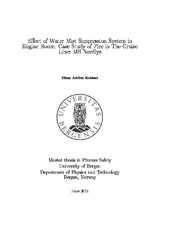Effect of Water Mist Suppression System in Engine Room: Case Study of Fire in The Cruise Liner MS Nordlys
Master thesis
Permanent lenke
https://hdl.handle.net/1956/21219Utgivelsesdato
2014-06-02Metadata
Vis full innførselSamlinger
Sammendrag
In the 1980s ozone layer depleting was a major concern for the environmentalists. Halon was used as a fire extinguishing agent until it was banned in the early 1990's. The industry was therefore forced to find other solutions to maintain fire protection. Water sprinkle, water mist, carbon dioxide (CO2) system, foam system and other gas based system was already in use, CO2 system was widely used in engine room and server rooms. CO2 system is harmful for human beings. The industry is aware of the situation and a change of mindset is in progress, this may change the industry standard. It is important that a new industry standard is grounded on a system that is safe for the environment and do not harm human beings. At the morning of the 15. September in 2011 a fire started in the engine room of MS Nordlys. Two people were killed during the fire and 9 were injured. The ship almost capsized after it was towed to quay in Ålesund. MS Nordlys was protected by carbon dioxide extinguishing system; this was not released during the fire. As an additional, or back up, extinguishing system MS Nordlys had a water mist system. The water mist system was in manual mode and it was released several minutes after the fire has started. The Norwegian Maritime Authority (NMA) wish to examine if water mist is a suitable extinguishing agent in engine rooms. They would also like to know if Fire Dynamic Simulator (FDS) is a useable Computing Fluid Dynamic (CFD) program to predict extinguishing of engine rooms. FDS is a widely used CFD program among fire safety engineers. FDS is an advanced program with many opportunities. This thesis addresses some of the challenges with FDS. In this thesis the following question will be answered: 1. How reliable is FDS when it predicts extinguishing in an engine room fire, using water mist as extinguishing agent? 2. How would a full protective water mist system with automatic release have preformed in the MS Nordlys Fire? 3. How could a FDS simulation be executed in a manner that is reliable and verifiable. 4. What benefits have water mist system compared with other extinguishing agent? Water mist has the potential to contribute to suppression and extinguishing of engine room fires. In order to find the key parameter of extinguishing, when using water mist as extinguishing agent, several simulation has been conducted. Auto ignition temperature, CO yield, k-factor, particle per second, critical flame temperature and the need for an ignition source was found as key parameter. Adding this in the simulation of MS Nordlys extinguishing was obtained. This project has shown that a well function water mist system, properly installed would most likely extinguish the fire on MS Nordlys within a minute. The following part is answer to the research question of this thesis. There are uncertainties of using FDS on engine room fire and water mist as extinguishing agent. The main concern is coupled to the extinguishing model that just uses the temperature effect. It is also challenges with the combustion model, but it is possible to use another combustion model. Even there are uncertainties with FDS, it predicted extinguishing when water mist was used as extinguishing agent. The simulation of MS Nordlys showed that the water mist system was able to suppress the fire, and when the experiment of USCG room is taken in account it is likely to believe that a water mist system would...
